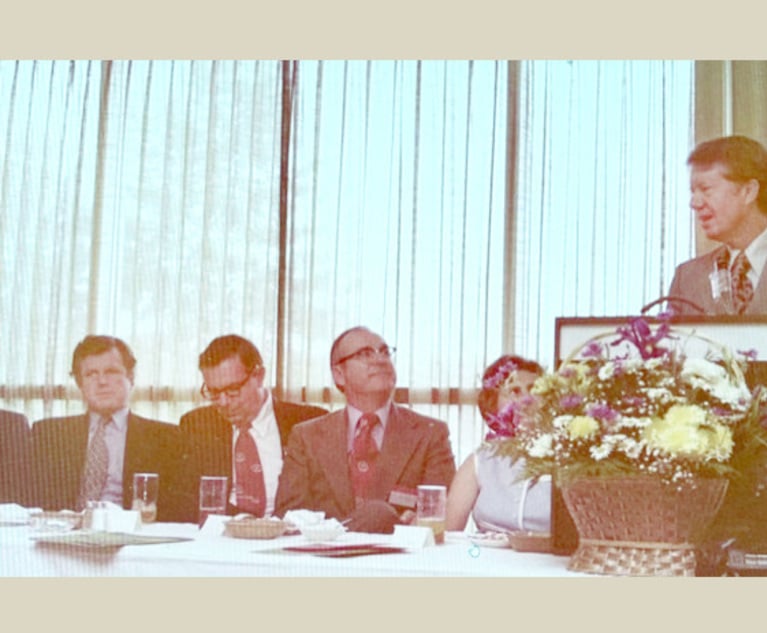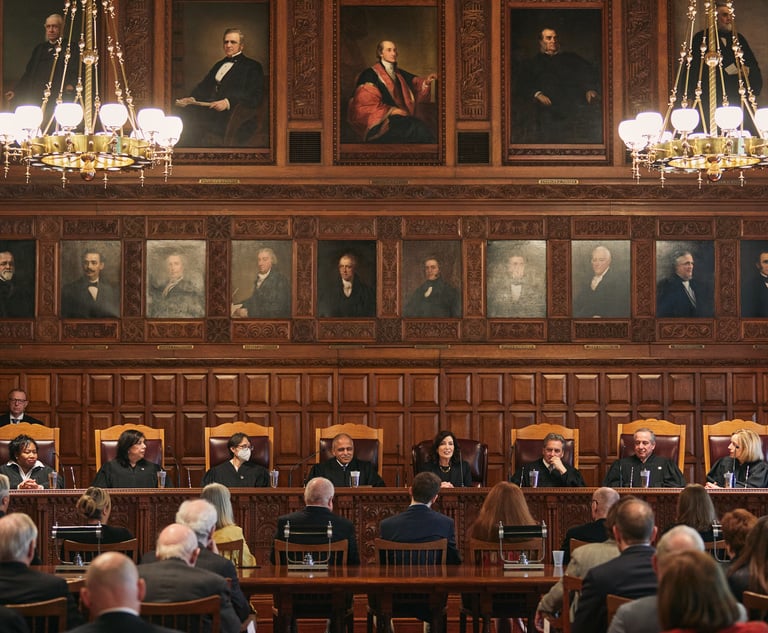OMG: The Future of the 'Excited Utterance' Doctrine in New York?
It seems that New York's "excited utterance" exception may be screaming out for further judicial review.
December 13, 2019 at 11:00 AM
8 minute read
 OMG!
OMG!
According to Irving Younger, the famed evidentiary guru, an excited utterance—one of the most durable exceptions to the hearsay rule—has to start with that exclamation to qualify as an admissible statement in New York.
But, wait.
"Oh, my God, excited utterances may be on their way out in New York."
Now, for the evidence aficionado, that's an excited utterance.
According to at least one Court of Appeals judge, the "excited utterance" doctrine may be a casualty of evolving science regarding its reliability, especially when the "utterer" may not be subject to cross-examination during the trial or hearing in which the statement is offered.
New York's reliance on the "excited utterance" doctrine as an exception to the hearsay rule is longstanding. Originally dubbed the "res gestae" exception, New York courts sought long ago to untangle that ancient concept from the actual statements that were uttered simultaneously with an unusual incident. Anderson v. Rome, 54 N.Y. 334 (1873). The Court of Appeals introduced a distinction between the action—"res gestae"—and the verbal utterance—the "spontaneous declaration"—as early as 1908 in People v. Del Vermo, 192 N.Y. 470 (1908). Even in that instance, the court grappled with whether statements made by a decedent after being stabbed, were actually "dying declarations" instead of excited utterances.
Later in Greener v. General Electric Co., 209 NY 135 (1913), the Court of Appeals held that a statement made by an injured worker in response to the question "what happened" moments after an accident occurred was inadmissible because, even though it was the first thing the injured worker said, the answer was more a "narrative" than a spontaneous declaration.
In 1979, the Court of Appeals extricated the "excited utterance" rule from the chains of res gestae. In People v. Edwards, 47 N.Y. 2d 493 (1979), the court approved the trial court's admission of statements made by a victim of an ice pick attack. Finding the utterances were "excited," the court reasoned:
Underlying this exception is the assumption that a person under the influence of the excitement precipitated by an external startling event will lack the reflective capacity essential for fabrication and, accordingly, any utterance he makes will be spontaneous and trustworthy … Since the utterance is made as a direct result of sensory perception during that brief period when considerations of self-interest cannot be immediately brought to bear, the declaration may be admitted into evidence as expressing the true belief of the declarant as to the facts observed.
Id at 497.
The "excited utterance" or "spontaneous declaration" has frequently dotted New York's legal landscape over the last decade. The "utterance" was often vocalized through a 911 call, which the prosecution sought to introduce at trial. The tape was often powerful evidence of a defendant's conduct, even though the declarant may not have testified.
In the last two years, however, the concept—and its inherent reliability or lack thereof—has come into question.
In People v. Cummmings, 31 NY 3d 204 (2018), Judge Rivera, concurring in a case involving a 911 recording, argued that the "excited utterance" doctrine required "serious reconsideration." Judge Rivera explained:
Legal scholars and jurists have questioned the continued vitality of this exception, in light of advances in psychology and neuroscience that demonstrate an individual's inability to accurately recall facts when experiencing trauma, and, in turn, to create falsehoods immediately.
Id at 213. In Cummings the prosecutor repeatedly played a 911 tape from an unknown declarant in which the defendant's unusual first name—Twanek—was repeatedly vocalized. The majority in Cummings held the statement inadmissible because there was no reasonable inference that the declarant " personally observed the incident." Id. at 211. The court majority declined Judge Rivera's invitation to comment on the vitality of the underlying doctrine.
In People v. Almonte, __ N.Y. 3d __ (2019), the court reviewed how "excited" the utterance must be to qualify for the exception. There, a robbery victim's 911 call was offered at trial. The victim was the sole eyewitness to a robbery. He claimed he was struck by a gun. He went to his house and his sister called 911. She said that her brother was shot. Minutes later, when the 911 operator called back, the victim stated that the perpetrators "put a gun to my head and they beat me up." The court majority held the utterance admissible because the victim's "nervous excitement" overcame his "reflective power," but eventually concluded the admission was harmless as there was substantial evidence of guilt.
Judge Rivera again dissented, arguing that the facts did not justify a conclusion that the statement occurred contemporaneous or immediately after the startling event. She noted that the call occurred several minutes later, the caller had no excitement in his voice, he failed to include critical evidence that he had known his attackers, and there was no evidence he lacked reflective capacity. The judge concluded that the exception does not apply when the declarant makes a calculated decision to withhold critical information about the startling event.
The Rivera dissent draws significantly from a concurring opinion of Judge Richard Posner in United States v. Boyce, 742 F.3d 792, 802 (7th Cir. 2014) (Posner, J. concurring). In that case, another 911 call was involved and Judge Posner commented:
It is time the law awakened from its dogmatic slumber. The "present sense impression" exception never had any grounding in psychology. It entered American law in the nineteenth century … long before there was a field of cognitive psychology; it has neither a theoretical nor an empirical basis; and it's not even common sense—it's not even good folk psychology.
Id. at 802. Judge Posner concluded that the exception for excited utterances "rests on no firmer ground than judicial habit, in turn reflecting judicial incuriosity and reluctance to reconsider ancient dogmas."
The science of faulty memory and fabrication can be disputed. But faulty perceptions and memories—even in highly unusual events—are ever-present. In 2015, a New York Times reporter took eyewitness statements from two bystanders in an alleged police shooting. One witness said the victim was running away and shot in the back; the other said the victim was shot when handcuffed. The police body cameras proved the victim was chasing an officer, wielding a hammer at the officer's head, shot and then handcuffed on the ground.
An expert evaluating the divergence of witness perceptions of the same incident noted: "It's pretty normal. That's the hard thing to get our heads around. It's frightening how easy it is to build in a false memory."
The "excited utterance" exception also challenges New York's reliance on "reliability," which the Court of Appeals has identified as the crucial factor in evaluating hearsay. In Nucci v. Proper, 95 N.Y.2d 597 (2001), the court noted that faulty memory or perception, insincerity, or ambiguity were the traditional testimonial infirmities that the hearsay rule was designed to guard against. But, faulty perceptions and equally flawed memories are seemingly swept aside when an anonymous 911 call identifying a perpetrator is offered at trial but the declarant never appears. This flaw logically appears to shake the foundation of reliability upon which the "excited utterance" is built.
New York courts continue to rely on 911 recordings as powerful evidence. See People v. Gill, 2019 NY MISC LEXIS 3628 (Sup. Ct. App. Term 2d Dept. 2019) (911 caller identified the defendant as drunk but never testified); People v. Anonymous, 2019 NY App. Div. LEXIS 5481 (1st Dept. 2019) (unknown 911 caller was describing "substantially contemporaneous events" and therefore admissible).
But as Judge Rivera cautions in Cummings and Almonte, the continued reliance on "excited utterances" as evidence in criminal trials seems to be open for question and ripe for a substantive challenge at trial. If the person behind the voice on a 911 call never appears at trial, the conventional tool to examine the reliability of the taped voice—cross-examination for bias or accuracy of recollection—is unavailable. Factor in the lack of scientific justification for the reliability of witnesses and the notion that instantaneous fabrication is perhaps just as likely as verisimilitude, then it seems that New York's "excited utterance" exception may be screaming out for further judicial review.
OMG indeed.
Justices John J. Ark, Daniel J. Doyle and William K. Taylor are Supreme Court Justices in the 7th Judicial District. Judge Richard A. Dollinger is a member of the Court of Claims and an acting Supreme Court Judge in the 7th Judicial District.
This content has been archived. It is available through our partners, LexisNexis® and Bloomberg Law.
To view this content, please continue to their sites.
Not a Lexis Subscriber?
Subscribe Now
Not a Bloomberg Law Subscriber?
Subscribe Now
NOT FOR REPRINT
© 2025 ALM Global, LLC, All Rights Reserved. Request academic re-use from www.copyright.com. All other uses, submit a request to [email protected]. For more information visit Asset & Logo Licensing.
You Might Like
View All
Jimmy Carter’s 1974 Law Day Speech: A Call for Lawyers to Do the Public Good
14 minute readTrending Stories
- 1Many LA County Law Firms Remain Open, Mobilize to Support Affected Employees Amid Historic Firestorm
- 2Stevens & Lee Names New Delaware Shareholder
- 3U.S. Supreme Court Denies Trump Effort to Halt Sentencing
- 4From CLO to President: Kevin Boon Takes the Helm at Mysten Labs
- 5How Law Schools Fared on California's July 2024 Bar Exam
Who Got The Work
Michael G. Bongiorno, Andrew Scott Dulberg and Elizabeth E. Driscoll from Wilmer Cutler Pickering Hale and Dorr have stepped in to represent Symbotic Inc., an A.I.-enabled technology platform that focuses on increasing supply chain efficiency, and other defendants in a pending shareholder derivative lawsuit. The case, filed Oct. 2 in Massachusetts District Court by the Brown Law Firm on behalf of Stephen Austen, accuses certain officers and directors of misleading investors in regard to Symbotic's potential for margin growth by failing to disclose that the company was not equipped to timely deploy its systems or manage expenses through project delays. The case, assigned to U.S. District Judge Nathaniel M. Gorton, is 1:24-cv-12522, Austen v. Cohen et al.
Who Got The Work
Edmund Polubinski and Marie Killmond of Davis Polk & Wardwell have entered appearances for data platform software development company MongoDB and other defendants in a pending shareholder derivative lawsuit. The action, filed Oct. 7 in New York Southern District Court by the Brown Law Firm, accuses the company's directors and/or officers of falsely expressing confidence in the company’s restructuring of its sales incentive plan and downplaying the severity of decreases in its upfront commitments. The case is 1:24-cv-07594, Roy v. Ittycheria et al.
Who Got The Work
Amy O. Bruchs and Kurt F. Ellison of Michael Best & Friedrich have entered appearances for Epic Systems Corp. in a pending employment discrimination lawsuit. The suit was filed Sept. 7 in Wisconsin Western District Court by Levine Eisberner LLC and Siri & Glimstad on behalf of a project manager who claims that he was wrongfully terminated after applying for a religious exemption to the defendant's COVID-19 vaccine mandate. The case, assigned to U.S. Magistrate Judge Anita Marie Boor, is 3:24-cv-00630, Secker, Nathan v. Epic Systems Corporation.
Who Got The Work
David X. Sullivan, Thomas J. Finn and Gregory A. Hall from McCarter & English have entered appearances for Sunrun Installation Services in a pending civil rights lawsuit. The complaint was filed Sept. 4 in Connecticut District Court by attorney Robert M. Berke on behalf of former employee George Edward Steins, who was arrested and charged with employing an unregistered home improvement salesperson. The complaint alleges that had Sunrun informed the Connecticut Department of Consumer Protection that the plaintiff's employment had ended in 2017 and that he no longer held Sunrun's home improvement contractor license, he would not have been hit with charges, which were dismissed in May 2024. The case, assigned to U.S. District Judge Jeffrey A. Meyer, is 3:24-cv-01423, Steins v. Sunrun, Inc. et al.
Who Got The Work
Greenberg Traurig shareholder Joshua L. Raskin has entered an appearance for boohoo.com UK Ltd. in a pending patent infringement lawsuit. The suit, filed Sept. 3 in Texas Eastern District Court by Rozier Hardt McDonough on behalf of Alto Dynamics, asserts five patents related to an online shopping platform. The case, assigned to U.S. District Judge Rodney Gilstrap, is 2:24-cv-00719, Alto Dynamics, LLC v. boohoo.com UK Limited.
Featured Firms
Law Offices of Gary Martin Hays & Associates, P.C.
(470) 294-1674
Law Offices of Mark E. Salomone
(857) 444-6468
Smith & Hassler
(713) 739-1250









